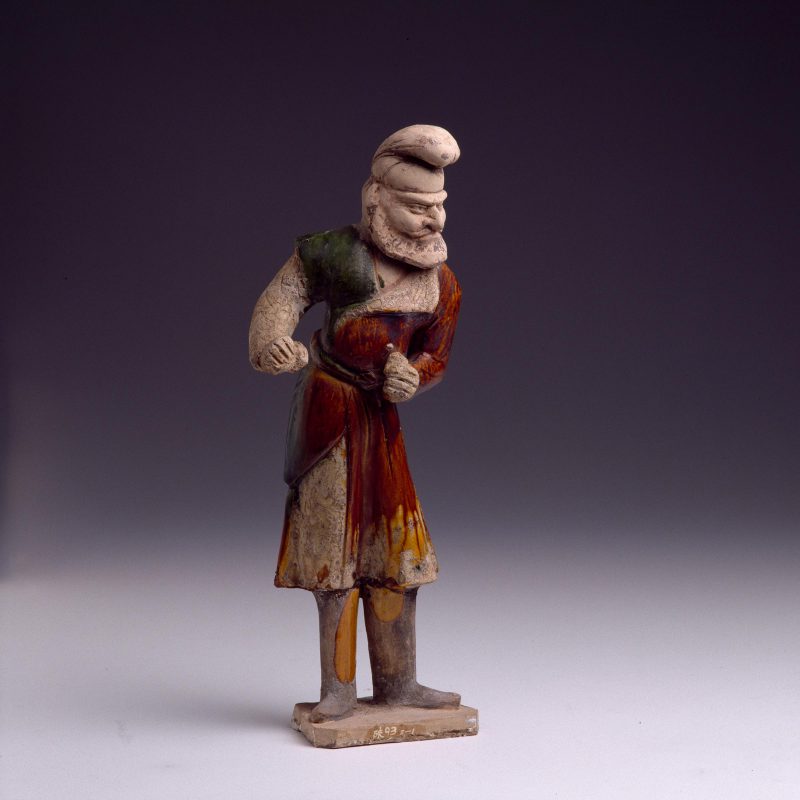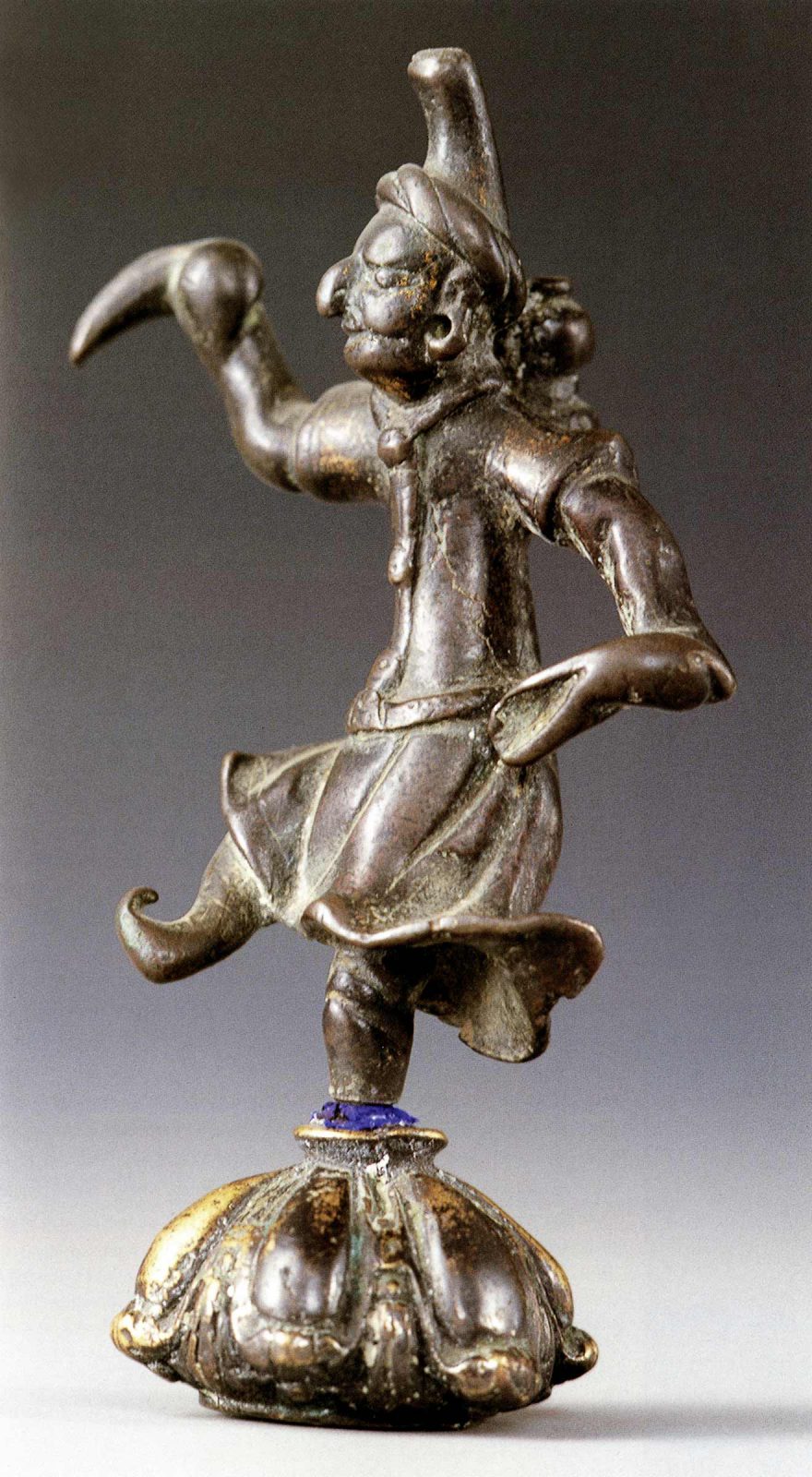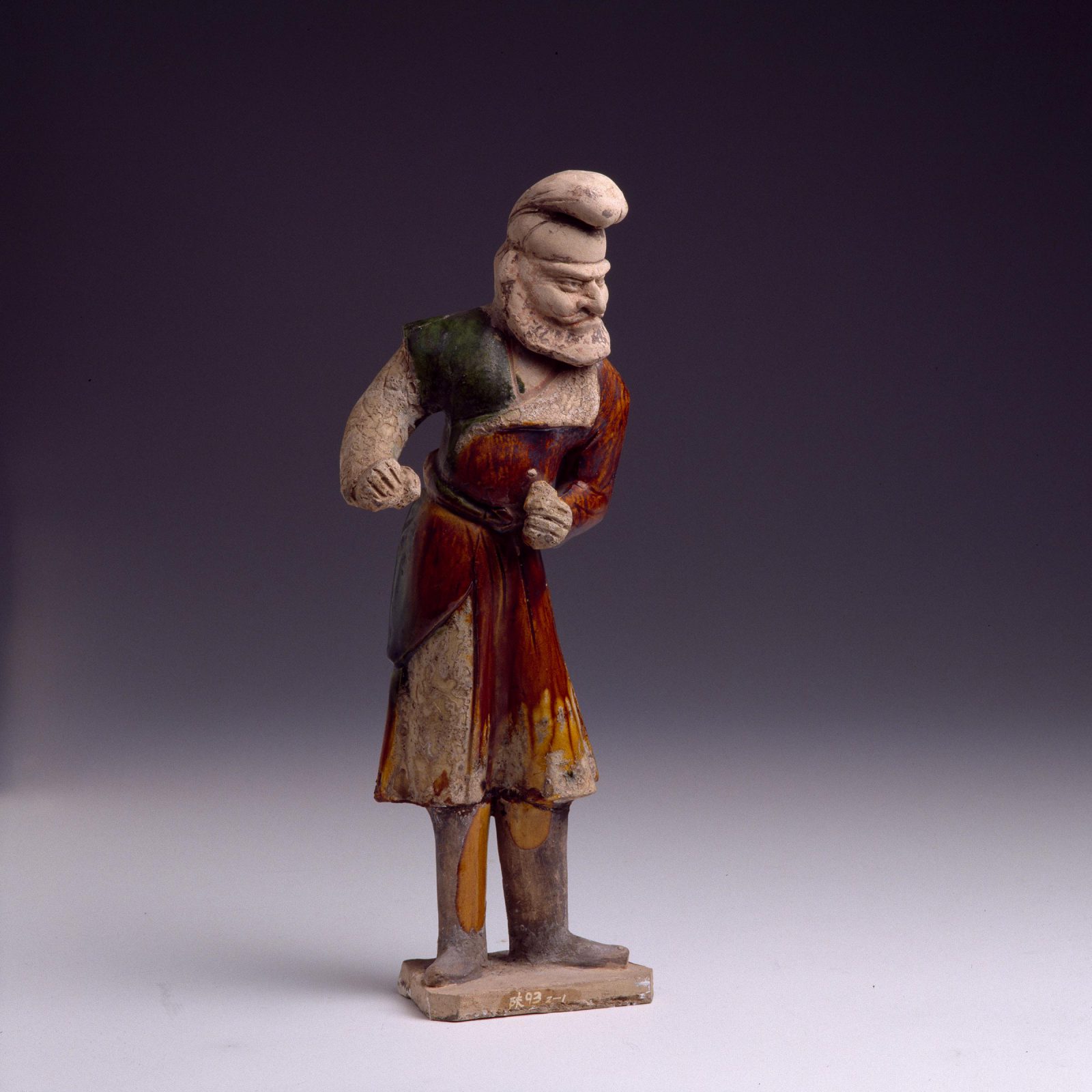Who Were the Sogdians,
and Why Do They Matter?
by Judith A. Lerner and Thomas Wide
Meet the Sogdians, an ancient Silk Road people whose major influence on world art, culture, and trade has only in the last fifty years begun to be fully understood.
Our world is shaped by influencers: people whose behavior and attitudes set the trends for what to wear, what to eat, what to like, what to buy. Such influencers do not rely on political power or authority. Rather, they use their social networks, access to specialist knowledge or goods, and cultural “cool” to shape the ways we behave. In our interconnected world, such influencers can have great reach, across continents and cultures. It is tempting to think that such influencers are a new phenomenon, facilitated by new technologies of communication. In fact, though, today’s influencers are not the first to reach across networks in this way. Almost 2,000 years ago there was a group of influencers who, while relatively few in number and limited in political power, helped to change the world around them. We call these people the Sogdians. Their site of influence: the Silk Road. More accurately, we should say the “Silk Roads,” as they were really a series of routes connecting various parts of Asia; Fig. 1.
The Sogdians were an Iranian people whose homeland, Sogdiana, was located at the center of several of those routes, in present-day Uzbekistan and Tajikistan. First recorded in the 5th century BCE as a province of the Achaemenid Persian Empire Fig. 2, and later conquered by Alexander the Great on his journey east across Asia, Sogdiana reached a peak of wealth and prominence during the 4th into the 8th centuries CE. During this time, Sogdiana was made up of a patchwork of oasis towns and rich agricultural land, uniquely placed between the great empires of the Asian continent; Fig. 3.

Fig. 4 The Sogdians’ combination of mobility and artistic skill are well-captured in this 8th-century Chinese tomb sculpture of Sogdian musicians on tour. View object page
Photograph © National Museum of China.
Perhaps more than any other people, the Sogdians capitalized on the opportunities of the Silk Roads, developing a merchant society that made great profit out of the trade between China and other parts of Asia. Mobile, multilingual, and highly skilled, the Sogdians were able to connect disparate regions, transfer goods and ideas across long distances, and oil the wheels of global trade and exchange. Through their travels, trade, and translations, the Sogdians helped shape a diverse range of arts, fashions, lifestyles, technologies, and religious ideas that transformed parts of the world far from their homeland; Figs. 4 and 5.

Fig. 5 Sören Stark (Institute for the Study of the Ancient World, New York University) describes the Sogdians’ network of commercial relationships across Asia.
This digital exhibition explores different dimensions of Sogdian art, culture, and influence through the material culture that survives to this day. It focuses on the time between the 4th and 8th centuries CE, which was the golden age of the Sogdians. Sogdian immigrant communities spread across China, South and Southeast Asia, and up into the Central Asian steppe and Mongolia. It was a period, too, in which their homeland of Sogdiana flourished, as Sogdian towns grew rich from the profits of the trade they fostered and the well-irrigated agricultural lands they cultivated. During this time, a highly sophisticated and distinct urban culture developed, epitomized by the grand houses of the elites, decorated with elaborate, richly colored wall paintings; Figs. 6–8. These have been found at various archaeological sites in Uzbekistan and Tajikistan during the 20th century and up to the present Fig. 9.

Fig. 6 Sogdian wall painting found at the archaeological site of Panjikent. View object page
Photograph © The State Hermitage Museum, SA-15901-15904

Fig. 7 Sogdian wall painting found at the archaeological site of Varakhsha. View object page
Photograph © The State Hermitage Museum, SA-14658-14675

Fig. 8 Sogdian wall paintings found at the archaeological site of Afrasiab. View object page
Photograph Thorsten Greve © Association pour la Sauvegarde de la Peinture d’Afrasiab and Freer Gallery of Art and Arthur M. Sackler Gallery, Smithsonian Institution.
Fig. 9 Drone footage taken at the Sogdian archaeological site of Panjikent, in modern-day Tajikistan. Courtesy of Pavel Lurje.
One of the most surprising elements of the Sogdians’ influence is that it did not rely on political or military power. They had no empire, and their political organization at home in Sogdiana was a series of small principalities, each with its own leader Fig. 10.

Fig. 10 Sören Stark (Institute for the Study of the Ancient World, New York University) discusses what first drew him to the study of the Sogdians.
Branching out from these oasis towns, the Sogdians set up merchant communities as they traveled, living under the aegis of various imperial powers. The people of Sogdiana certainly had armies, engaged in military campaigns, and fortified their towns to defend against the constant threat of nomads from the steppes who coveted the Sogdians’ wealth—but their success was not defined by military might. Rather, the Sogdians made a virtue of their mobility, flexibility, and individuality. This mobility meant that they could connect distant regions, doing business in goods that could find ready markets in faraway places.
Their flexibility meant that they could adapt to foreign cultures, languages, and make profit of new opportunities as they emerged. The individuality of their culture—its seeming “otherness” and distinctiveness—was part of what the Sogdians packaged and sold abroad. This was especially true in Tang-era China (618–907 CE), which was a culture characterized by its love of the “exotic” and foreign. There the Sogdians and what they traded found much favor; Fig. 11.

Fig. 11 Judith A. Lerner (Institute for the Study of the Ancient World, New York University) discusses relationships between the Sogdians and Chinese.
In terms of trade, the Sogdians dealt in silk, of course, but also in other prized goods. Among these were horses from the Ferghana Valley, gemstones from India, musk from Tibet, furs from the steppes to the north, and even the famed “golden peaches of Samarkand” described in Chinese poetry. The Sogdians were also skilled artisans, making and selling luxurious objects—particularly metalworkSogdian Metalworking Learn more about Sogdian metalwork and textiles—across the Asian steppe and into China; Figs. 12 and 13.
It was not just goods that the Sogdians exported, but also fashionsSogdian Fashion Learn more about Sogdian fashion and forms of entertainmentBanqueting in Sogdiana Learn more about banqueting in Sogdiana; Fig. 14. Their apparel became all the rage in Tang China. Ladies of the Tang court dressed in kaftans and open-front jackets with long narrow sleeves, tapered trousers, and boots. Actually, they cross-dressed, since these were the garments of Sogdian and other Central Asian men.

Fig. 15 This sculpture from western China captures the lively energy of the “Sogdian Whirl.” View object page
After Annette L. Juliano and Judith A. Lerner. Monks and Merchants: Silk Road Treasures from Northwest China, Gansu and Ningxia, 4th-7th Century (New York: Harry N. Abrams and Asia Society Museum, 2001), p. 255, no. 82.
Such fascination with foreign dress was linked to the popularity—from courtly circles to neighborhood gathering places—of foreign food, music and musical instruments, and dance. In particular, the energetic “Sogdian Whirl” became a hit across all echelons of Chinese society; Fig. 15. Such dancing was often performed in the local taverns and this, combined with the fact that wine shops in China were frequently run by Sogdians, may have led to the “drunken Sogdian” becoming a stock character in Chinese and Japanese culture. The Sogdian languageSogdian Language and Its Scripts Learn more about the Sogdian language served as the lingua franca of the Silk Road, and many Sogdians were able to speak multiple languages due to the necessities of trade and the profitability of translations. Thus they were also ideally placed to play the roles of diplomats and transmitters of religious texts and ideas. We know, for example, that some of the early translators of Buddhist scriptures were of Sogdian origin. Sogdiana and its network of caravan routes reaching to China also provided a key conduit for the eastward spread of BuddhismXuanzang Learn more about the Chinese Buddhist traveler Xuanzang. Christianity and Manichaeism also spread partly through Sogdiana and by Sogdian hands; Fig. 16.

Fig. 16 Nicholas Sims-Williams (School of Oriental and African Studies) discusses the Sogdian texts that have survived to this day.

Fig. 17 This wall painting of the Hindu deity Shiva, found at Panjikent in modern-day Tajikistan, combines elements of Indian, Greek, and Iranian iconography. View object page
Photograph © The State Hermitage Museum, V-2704.
Perhaps unsurprisingly, considering their contact with multiple religions abroad, the Sogdians themselves practiced a wide variety of religious beliefs. At home in Sogdiana, they primarily followed Mazdaism, but also Hinduism, Buddhism, Christianity, Shaivism, Judaism, and Manichaeism. Abroad—or at least in China—they seem to have pursued their native religion, Mazdaism, but with some adaptation to the culture around them. Surviving evidence suggests that the Sogdians were not only pluralistic in their religious practices, but also syncretic, adopting and adapting other culture’s deities to serve their own devotional needs; Fig. 17. The combination of wealth and contact with a diverse range of cultures produced a unique artistic culture, too, manifested across multiple media. Excavations in Uzbekistan, Tajikistan, and in Xinjiang as well as other parts of China during the last century have revealed magnificent wall paintings in a rich palette of colors; Figs. 18 and 19.
Additional artifacts have included delicate silk textiles, finely wrought metalwork made from silver and gold, and elaborately carved wood and molded clay objects. Such discoveries have allowed us to build an increasingly detailed picture of Sogdian visual culture. While the art of Sogdiana is varied, certain common threads unite much of it. Particularly striking is its strong narrative dimension; its keen attention to social pursuits such as banqueting, hunting, entertainment, and story telling; and its receptivity to incorporating elements of subject matter and style from neighboring cultures; Figs. 20 and 21.
Fig. 20 This Sogdian wall-painting, now in the State Hermitage Museum in St Petersburg, exhibits various common elements of Sogdian painting, most particularly its strong narrative dimension. View object page
Photograph © The State Hermitage Museum, SA-15901-15904.

Fig. 21 Judith A. Lerner (Institute for the Study of the Ancient World, New York University) describes the “Sogdian aesthetic.”
Despite the Sogdians’ central role in the workings of the Silk Roads, these people were largely forgotten and lost to history for a thousand years. In Sogdiana, the great sweep eastward of Muslim armies in the 7th and 8th centuries CE led to the collapse of the local Sogdian ruling families, and the gradual conversion of Sogdiana to Islam as it was absorbed into successive Muslim empires. In China, the rebellion of the Sogdian-Turkic general An Lushan (d. 757 CE) against the Tang emperor in the 750s CE led to a decline in the fortunes of many in the Sogdian communities there, as they were increasingly treated with suspicion and even hostility. Many Sogdians in China actively assimilated, and over several generations their distinctive Sogdian identity was lost.
With the disappearance of the Sogdian people, their language, their historical documents, and their architecture were also lost. Lost, that is, until the late 19th and early 20th centuries, when scholars first discovered archaeological sites containing Sogdian material, from ancient letters written in the Sogdian script to monumental wall paintings; Figs. 22 and 23.
These scattered fragments allowed scholars to start reconstructing the Sogdians’ history and material culture. Nevertheless, the Sogdians’ influence remained underappreciated until quite recently. One reason for this was that the Sogdians rarely played the roles of the “great men” of traditional written history. They were merchants, artisans, entertainers, and farmers rather than kings, generals, or religious leaders. This meant their more subtle, but highly significant, influence on various Asian cultures was often overlooked. A second reason is that since the Sogdians were never a single, coherent political entity and were not confined to a bounded geographic region, there was never a modern nation-state to claim them as ancestors. The Sogdians thus suffered from being a “homeless” people, neglected by scholars more interested in constructing national histories than exploring a highly mobile people who crossed geographic, political, and cultural boundaries.
Such a state of affairs has, fortunately, been turned on its head over the last thirty years. Scholars have become increasingly interested in global, “interconnected” history, as well as in the social and cultural lives of everyday people (what one might call “non-elites”), rather than the former “top-down” diet of great deeds by great men. These scholars have also enthusiastically taken up analytic concepts such as “mobility” and “hybridity” as means to understand history. These academic interests are clearly a product of the age in which we live, when we are grappling with the contours of a globalized, highly networked world, and where we are very conscious of the fluid and constructed nature of personal and national identities.
From this perspective, the Sogdians seem to make an ideal subject. Here we see a multilingual, highly mobile culture that built its success on its ability to move between worlds, its openness to other cultures, and its peaceful activities of trade and agriculture, instead of on military force and power politics. In this reading, the Sogdians look to us like a model of successful cosmopolitanism in action. We should be wary of overstating this. The Sogdians were not averse to military campaigns. They enforced a strict hierarchy in their social formations that was certainly not egalitarian. They also participated in the “dark side” of Silk Road trade, from slavery to (most likely) prostitution. The Sogdians were not some proto-version of a 21st-century liberal democracy. Nevertheless, there remains something positive and alluring about many dimensions of Sogdian life and culture—especially at this moment in our shared world history. This digital exhibition is the product of several years’ work by a multidisciplinary team of scholars from around the world; Figs. 25–27. Subjects as dynamic and fluid as the Sogdians and their visual culture have required an equally dynamic partnership among multiple institutions. Vital among these have been the Smithsonian’s Freer Gallery of Art and Arthur M. Sackler Gallery; The State Hermitage Museum (St. Petersburg); the Bard Graduate Center; and New York University’s XE: Program in Experimental Humanities and Social Engagement, as well as its Institute for the Study of the Ancient World. This team presents various dimensions of Sogdian culture, from art, music, and feasting, to religion and funerary practices, grounding its presentation in the material culture that survives to this day.
The project has provided the impetus for convening scholars of Sogdian art and culture, photographing objects in collections around the world, and creating new 3-D models. We invite you to dive deeper, explore Sogdian objects, travel the Silk Roads on the interactive map, watch leading scholars discuss their latest research, and discover the most important people you had (maybe) never heard of.
Coined in 1877 by the German geographer Ferdinand von Richthofen (1833–1905), this term for the network of “roads” could just as accurately have been called the “Glass Road(s),” or “Jade Road(s),” or even the “Rhubarb Road(s)” after the other exotic or more mundane commodities that were moved along it.

























